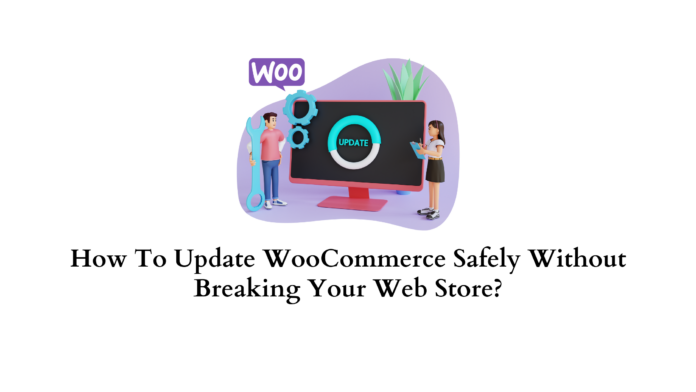WooCommerce releases constant updates with new features and security patches. You know updating is important to get the latest functionality and keep your store secure, but you’re worried about updating and breaking something. After all, your whole business depends on your WooCommerce store running smoothly.
The good news is with some best practices, you can update WooCommerce without breaking your store.
In this article, you’ll learn how to back up your store, test updates, update plugins, and monitor your store to ensure updates don’t bring in any issues.
The Importance of Keeping WooCommerce Updated


It is critical to keep your WooCommerce store up to date with the latest version. Here are a few reasons why:
Security
Older versions of WooCommerce may include vulnerabilities that hackers can exploit, affecting your store’s security and compromising your customers’ personal information. You can protect your business and maintain your customers’ confidence by using the most recent version of WooCommerce.
Compatibility
If you do not upgrade your WooCommerce store, you may have difficulties, compatibility issues, or possibly lose all functionalities. Regular WooCommerce upgrades can help keep you a step ahead of these issues and ensure that your business functions properly.
New Features
Updating WooCommerce allows you to take advantage of the new features and upgrades introduced in each release. These updates are designed to enhance the user experience, optimize performance, and even boost your sales.
By keeping WooCommerce up to date, you can have the latest features and a secure, optimized store that keeps your customers satisfied.
Steps to Backup and Update WooCommerce Safely
To update WooCommerce without causing issues, follow these steps:
Step 1: Backup Your Site
Make a complete backup of your site before updating. This ensures you have a copy to revert to if something goes wrong. This process can be done manually, but it is not recommended as it can cause issues while restoring if not done right. It is better to use a plugin like UpdraftPlus to back up your Database, WooCommerce settings, and Store files.


Once the plugin is installed and activated, go ahead and access it by going to Dashboard > Settings > UpdraftPlus Backup.
As soon as you enter the plugin’s dashboard, you can see a Backup Now button. Once you click on the button, go ahead and select the areas you want to backup such as the database and files.




Additionally, you may choose if you wish to send the backup to a remote location. (To do this, go to the settings tab in the plugin and choose your remote location like Dropbox)


Once done, go ahead and click Backup Now on the bottom of the pop-up. This will initiate the backup and it will take a few minutes depending on the size of your store.
Once the backup is complete, you can see the file under Existing Backups. The plugin backs up your database, plugins, themes, uploads, and all other files which you can individually download by clicking on the respective button.


Once you have updated your WooCommerce store, you may head back to this page and click on Restore next to the latest backup. It’s that easy!
Step 2: Update WooCommerce Core
Log in to your WordPress admin and go to Plugins > Installed Plugins. Find WooCommerce and click Update now on the alert below the plugin. This will update the WooCommerce plugin to the latest version.
Once WooCommerce has been updated, you will be prompted to update the WooCommerce Database. To do so click Update WooCommerce Database on the top of your dashboard.


You can view the progress by going to Dashboard > WooCommerce > Status > Scheduled Actions. You will see a pop-up once the update is complete.


Step 3: Test and Review
Test your store thoroughly to ensure everything is working properly with the update.
Look for any issues and fix them before re-opening your store. It’s best to test on a staging site first if you have one.


Step 4: Check Plugin Compatibility
See if any plugins you use are compatible with the new WooCommerce version. Developers usually update their plugins shortly after a WooCommerce release. You may need to temporarily disable some plugins until updates are available.


Step 5: Update Plugins and Themes
Update any WooCommerce extensions, payment gateways, or your theme to versions compatible with the new WooCommerce update. This prevents integration issues that could impact your store.


Step 6: Inform Customers (If Reopening Store)
If you had to temporarily close your store for updating and testing, let your customers know you’re open again. Send an email, post on social media, and add a notice to your store. Apologize for any inconvenience during the update.
Following these steps will help ensure updating WooCommerce goes smoothly and your store remains fully functional. If issues come up, you have a backup to roll back to and get your store running again quickly.
Understanding WooCommerce Version Compatibility
Here are some best practices for understanding version compatibility and updating safely:
Check Plugin and Theme Compatibility
Prior to updating, confirm that any WooCommerce themes or plugins you use are compatible with the most recent version of WooCommerce. Version compatibility is often listed on product sites. If there are incompatibilities, either delete the plugin or theme or wait for the creators to release compatible versions before updating.
Check the Update Notes
Every update for WooCommerce includes a release note or changelog that lists all new features, bug fixes, and possibly risky changes. To ensure you know what to anticipate, go over the notes for the version you intend to update. Keep an eye out for any changes that could be problematic.
Test on a Staging Site
Prior to updating the live store, try the WooCommerce update on a staging site. A staging site is an identical replica of your live shop that is used for testing. Before updating the live site, make sure everything is operating as it should and make any required changes.
Turn Off Caching
Disable any caching plugins and services prior to applying the update. Caching occasionally causes problems and interferes with updates.
Update WooCommerce
When you’re ready to upgrade, begin with WooCommerce. After that is finished and everything appears to be in order, update your theme and plugins. Check your website after updating each plugin or theme, one at a time. This simplifies identifying the problem and finding a solution.
By following these recommended practices, you may update WooCommerce with ease and avoid any issues. Take your time and make sure your store is operating properly after every upgrade.
Plugins to Deactivate Before Updating WooCommerce
To prevent incompatibilities, it’s a good idea to disable specific plugins prior to updating WooCommerce. Here are some plugin categories you may want to disable:
Theme Plugins
WooCommerce is modified by theme plugins to function with your particular theme. Before updating them, deactivate them to prevent conflicts.
Outdated or Unused Plugins
When a plugin isn’t updated for more than two years, it’s probably been abandoned and might lead to issues. Before updating WooCommerce, deactivate them. Verify whether you still require the functionality or if there are any other current plugin options.
Payment Gateway Plugins
Plugins for payment gateways make it easier to process payments. Because of their close integration with WooCommerce, disabling them for a short while avoids payment problems while updating.
Shipping Plugins
Similar to payment gateways, WooCommerce, and shipping plugins are closely integrated. Before updating them, deactivate them to prevent issues with label printing or shipment calculations.
By following these recommended practices, you can make sure that your store updates without any issues. Before bringing your store back online, make sure to reactivate and test plugins to ensure compatibility.
Conclusion
So there you have it, a guide on how to update WooCommerce in a safe and easy way. The key is to go about it in a stepwise manner and plan ahead. Make backups, review the changelog, test updates on a staging site, and update one plugin or theme at a time.
While the update process can seem tedious, your customers will thank you for a seamless experience while browsing your website. Staying on top of WooCommerce updates is well worth the time to keep your store secure and running smoothly.
We hope this post has helped you update your WooCommerce store without any hassle!











